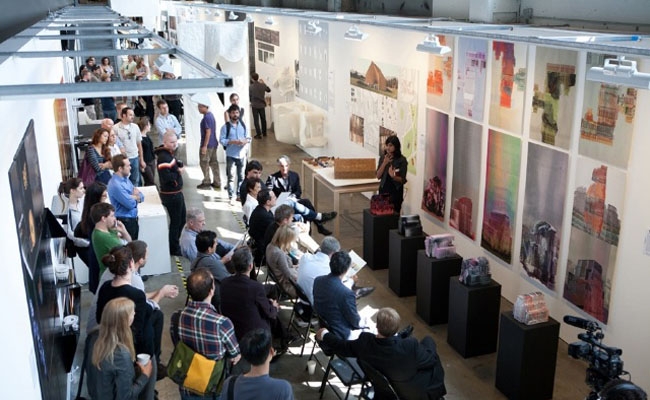✱ Rejection is Good for You

Rejection is something every person working in a creative field has to learn to deal with if they want to get better at what they do. It's an essential tool that must be learned and put to use, as scary as it is. There are lots of people that think we get to do the "fun" job being the creative. While I would agree about the fun part, there are lots of non-fun aspects to the job that are actually downright terrifying sometimes. It takes a lot of guts to be vulnerable and put your work out there in front of others for it to be judged. Many people overlook this difficult part of the job.
For those of you unfamiliar with a common part of an architect's education, a jury of academics and professionals come together to critique a student's work that has typically been pinned up on a wall for everyone to see. It's called a Crit, which is short for "critique". The Crit is the home of rejection in an architect's life. It's what we do with the rejection is what separates the professionals from the amateurs.
Wikipedia states:
Criticism is the practice of judging the merits and faults of something (or somebody) in an intelligible (or articulate) way.
- The judger is called "the critic".
- To engage in criticism is "to criticise"/"criticize".
- One specific item of criticism is called "a criticism" or a "critique".
Criticism as an evaluative or corrective exercise can occur in any area of human life.
The Crit

A fairly standard setting of a Crit. This one happens to be at sci-arc. Click to embiggen.
While rejection is definitely not limited to architecture, it's the perspective I'm coming from. Architecture school was and is a good place to learn how to develop a thick skin because of the critiquing process students go through when presenting their projects. It's where we learned how to deal with rejection. Sometimes it was relentless. People cried.
It is the role of the designer to use said criticism to make the next project better as it is probably too late to make the current one any better because there is no time left. Make sure you understand: the goal is to make the project better. It is often a misunderstood method. Most of the time, at least early on, the student takes it personally. They shouldn't.
I always loved how after working tirelessly for weeks on end at a breakneck speed to hear "It was a good first pass" at the final presentation. The irony.
I've also noticed that we tend to lose touch with the idea of the Crit after school. A lot of times we take it personally because of our inability to separate ourselves from the work. Designers pour their lives into their work and it becomes an extension of them, so it makes sense. Other times it's taken personally because of the inability for some jurors to make a constructive criticism. Some jurors response and/or tone is often demoralizing and full of their own ego. We get to hear all about how they would have done it (so perfectly I might add). This is a problem, but not the point of this article. Those kinds of comments and attacks should be dismissed immediately.
I was sent links to these articles about rejection, and they are very well written so I thought I'd share them. I wish I’d read these years ago during school, but it's great to read them as reminders now. To be able to use rejection and criticism as a tool is a powerful thing. I've included just a small quote from each article but they really are worth reading in their entirety.
Rejection and the designer by Lisa Shaughnessy:
What are the results of working in a discipline where rejection, and its first cousins, compromise, dilution and modification, are ubiquitous? Does rejection harden ambition and act as a spur to better work? Or does it inject a debilitating toxin into the organs of creative ambition?
Of course it’s not social rejection that designers fear, but it’s almost as deeply felt, and strikes at the core of what it means to be a creative producer. How designers cope with rejection of their work is fundamental to how they progress and develop as creative practitioners.
And there’s a paradox here for designers: if we wish to avoid rejection we nearly always have to choose blandness, but on the other hand, if we want to make work with depth and resonance, we have to risk rejection. So unless we decide to settle for blandness and cosy consensus, we have to live with the near permanent threat of rejection.
So many great points. I must hold back from quoting more... please go read it for yourself.
And then there's this article coming from the perspective of a writer that easily crosses over into other creative work. The author describes why it's good to get rejected:
Get Rejected by Lisa Carver:
It may say something about you, positive or negative, that your piece (or your love) was rejected, or it may say absolutely nothing at all about you. (Same with having your piece accepted.) Rejection, personally or professionally, is only saying this doesn’t fit here. Maybe it used to, or maybe it would if this and this changed, but right now, as is, no. It may be a case of wrong time, wrong place, or it may be that what you wrote is just plain uninteresting. Some things you write are going to be pretty bad. It’s good to get notice that there’s something more you could be doing, writing, thinking, experiencing. Why be hurt by that? Go do something bigger, go try it.
Once you stop being frightened of saying no, that’s when you can say a real yes when it’s yes. When you stop being frightened of getting told no, that’s when you stop being frightened of their yes not being really yours, and you no longer need to worry over either a yes or a no like a dog with a bone about to be snatched. Get good with rejection, and you’ll be able, finally, to be accepted. And cherished. And celebrated. Every once in a great while. And you’ll know it’s yours.
Even now I use the critique/jury process during the development of my projects. It allows me to get a wide range of alternative perspectives to view my work; a 'fresh set of eyes' as they say. It takes deliberate thought and action for me to make sure I take the crit as potential ideas to make the work better. To not take it personally. It's then my job to weed through the comments and different points of view—to take some to heart and to leave others in a ditch by the side of the road as I speed off and never look back.
We did an Archispeak podcast episode on critique and criticism where we explored the subject more. The comments on the page by some of our listeners are golden.
The bottom line is that the Crit is the important part, and rejection is good for you. It's where you listen, and it's a tool you can use to become better at your craft. Once you figure this out, you actually start looking forward to Crits because they can provide clarity. If they don't, there are two things wrong: You're either not inviting the right people, or you're not doing it right.


